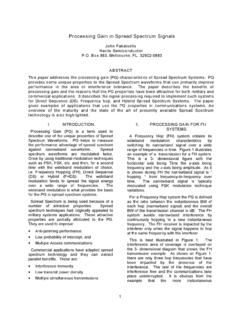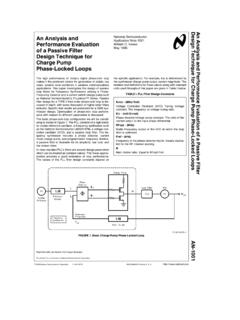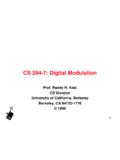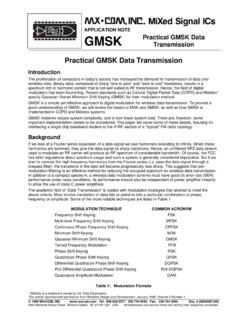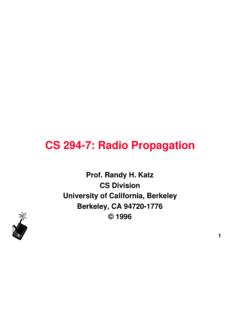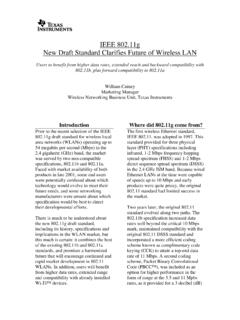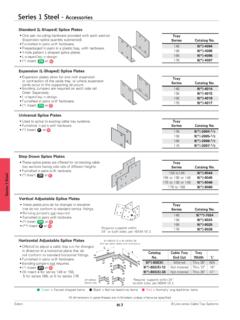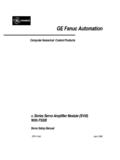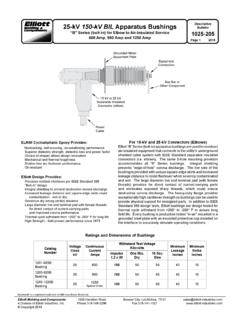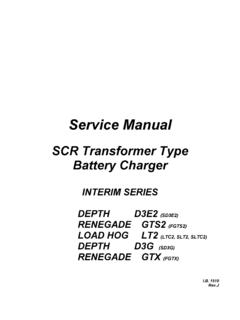Transcription of SECTION 9 HARDWARE DESIGN TECHNIQUES
1 1 SECTION 9 HARDWARE DESIGN TECHNIQUESP rototyping Analog CircuitsEvaluation BoardsNoise Reduction and Filtering forSwitching Power SuppliesLow Dropout References and RegulatorsEMI/RFI ConsiderationsSensors and Cable Shielding2 SECTION 9 HARDWARE DESIGN TECHNIQUESWalt Kester, James Bryant, Walt Jung,Adolfo Garcia, John McDonaldPROTOTYPING AND SIMULATING ANALOG CIRCUITSWalt Kester, James BryantWhile there is no doubt that computer analysis is one of the most valuable tools thatthe analog designer has acquired in the last decade or so, there is equally no doubtthat analog circuit models are not perfect and must be verified with HARDWARE .
2 If theinitial test circuit or "breadboard" is not correctly constructed, it may suffer frommalfunctions which are not the fault of the DESIGN but of the physical structure ofthe breadboard itself. This SECTION considers the art of successful breadboarding ofhigh performance analog electronic circuits contain many "components" which were not present in thecircuit diagram, but which are there because of the physical properties ofconductors, circuit boards, IC packages, etc. These components are difficult, if notimpossible, to incorporate into computer modeling software, and yet they havesubstantial effects on circuit performance at high resolutions, or high frequencies, is therefore inadvisable to use SPICE modeling or similar software to predict theultimate performance of such high performance analog circuits.
3 After modeling iscomplete, the performance must be verified by is not to say that SPICE modeling is valueless - far from it. Most modern highperformance analog circuits could never have been developed without the aid ofSPICE and similar programs, but it must be remembered that such simulations areonly as good as the models used, and these models are not perfect. We have seen theeffects of parasitic components arising from the conductors, insulators andcomponents on the PCB, but it is also necessary to appreciate that the models usedwithin SPICE simulations are not perfect an operational amplifier.
4 It contains some 20-40 transistors, almost asmany resistors, and a few capacitors. A complete SPICE model will contain all thesecomponents, and probably a few of the more important parasitic capacitances andspurious diodes formed by the diffusions in the op-amp chip. This is the model thatthe designer will have used to evaluate the device during his DESIGN . In simulations,such a model will behave very like the actual op-amp, but not MODELINGSPICE modeling is a powerful tool for predicting the performanceof analog Devices provides macromodels for over 450 ICsHOWEVERM odels omit real-life effectsNo model can simulate all the parasitic effects of discretecomponents and a PCB layout THEREFOREP rototypes must be built and proven before , this model is not published.
5 As it contains too much information whichwould be of use to other semiconductor companies who might wish to copy orimprove on the DESIGN . It would also take far too long for a simulation of a systemcontaining such models of a number of op-amps to reach a useful result. For these,and other reasons, the SPICE models of analog circuits published by manufacturersor software companies are "macro" models, which simulate the major features of thecomponent, but lack some of the fine detail. Consequently, SPICE modeling does notalways reproduce the exact performance of a circuit and should always be basic principle of a breadboard is that it is a temporary structure, designed totest the performance of a circuit or system, and must therefore be easy to are many commercial breadboarding systems, but almost all of them aredesigned to facilitate the breadboarding of digital systems, where noise immunitiesare hundreds of millivolts or more.
6 (We shall discuss the exception to this generalitylater.) Non copper-clad Matrix board (Vectorboard, etc.), wire-wrap, and plug-inbreadboard systems (Bimboard, etc.) are, without exception, unsuitable for highperformance or high frequency analog breadboarding. They have too high resistance,inductance, and capacitance. Even the use of standard IC sockets is BREADBOARDING TECHNIQUESThe most practical technique for analog breadboarding uses a copper-clad board as aground plane. The ground pins of the components are soldered directly to the planeand the other components are wired together above it.
7 This allows HF decouplingpaths to be very short indeed. All lead lengths should be as short as possible, andsignal routing should separate high-level and low-level signals. Ideally the layoutshould be similar to the layout to be used on the final PCB. This approach is oftenreferred to as "deadbug" because the ICs are often mounted upside down with their4leads up in the air (with the exception of the ground pins, which are bent over andsoldered directly to the ground plane). The upside-down ICs look liked deceasedinsects, hence the shows a hand-wired breadboard based around two high speed op ampswhich gives excellent performance in spite of its lack of esthetic appeal.
8 The IC opamps are mounted upside down on the copper board with the leads bent over. Thesignals are connected with short point-to-point wiring. The characteristic impedanceof a wire over a ground plane is about 120ohms, although this may vary as much as 40% depending on the distance from the plane. The decoupling capacitors areconnected directly from the op amp power pins to the copper-clad ground. Whenworking at frequencies of several hundred MHz, it is a good idea to use only one sideof the board for ground. Many people drill holes in the board and connect both sidestogether with short pieces of wire soldered to both sides of the board.
9 If care is nottaken, however, this may result in unexpected ground loops between the two sides ofthe board, especially at RF frequencies."DEADBUG" PROTOTYPE TECHNIQUEF igure of copper-clad may be soldered at right angles to the main ground plane toprovide screening, or circuitry may be constructed on both sides of the board (withconnections through holes) with the board itself providing screening. In this case,the board will need legs to protect the components on the underside from the components of a breadboard of this type are wired point-to-point in the air(a type of construction strongly advocated by Robert A.)
10 Pease of NationalSemiconductor (Reference 1) and sometimes known as "bird's nest" construction)there is always the risk of the circuitry being crushed and resulting if the circuitry rises high above the ground plane, the screening effect of theground plane is diminished, and interaction between different parts of the circuit ismore likely. Nevertheless the technique is very practical and widely used becausethe circuit may so easily be "deadbug" prototype is shown in Figure The board is single-sidedcopper clad with holes pre-drilled on " centers.
